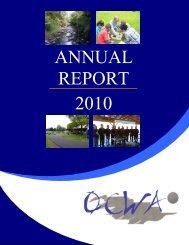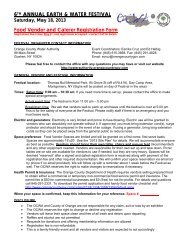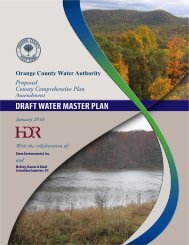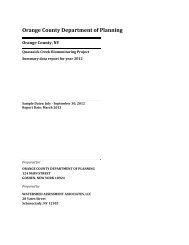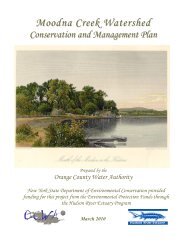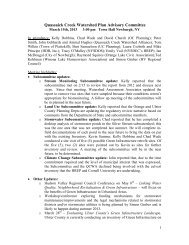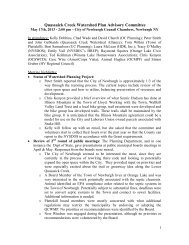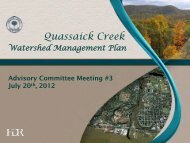Biodiversity of the Moodna Creek Watershed - Orange County Water ...
Biodiversity of the Moodna Creek Watershed - Orange County Water ...
Biodiversity of the Moodna Creek Watershed - Orange County Water ...
Create successful ePaper yourself
Turn your PDF publications into a flip-book with our unique Google optimized e-Paper software.
Appendix A. Flagship Species <strong>of</strong> <strong>the</strong> <strong>Moodna</strong> <strong>Creek</strong> <strong><strong>Water</strong>shed</strong><br />
The following wildlife species represent <strong>the</strong> diversity <strong>of</strong> habitats in <strong>the</strong> <strong>Moodna</strong> <strong>Creek</strong> watershed. In many cases, conservation <strong>of</strong> <strong>the</strong>se species will<br />
contribute to conservation <strong>of</strong> o<strong>the</strong>r plants and animals with similar habitat needs. Information on recommended habitat and buffer sizes, important<br />
temporal considerations, and additional conservation concerns are included. (Note that many <strong>of</strong> <strong>the</strong>se species use a complex <strong>of</strong> different habitats, in<br />
addition to <strong>the</strong> priority habitat group listed here.)<br />
Common Name<br />
Red-shouldered hawk<br />
Buteo lineatus<br />
Priority Habitat<br />
Group<br />
Forests<br />
Habitat Needs<br />
Varies from bottomland hardwoods and<br />
riparian areas to upland deciduous or mixed<br />
deciduous-conifer forest, and almost always<br />
includes some form <strong>of</strong> water, such as a<br />
swamp, marsh, river, or pond. Breeds in<br />
extensive forested habitat; a minimum <strong>of</strong> 620<br />
ac (250 ha) <strong>of</strong> floodplain forest may be<br />
necessary for successful breeding. Habitat<br />
overlaps with barred owl's.<br />
Conservation Considerations<br />
May be especially sensitive to fragmentation <strong>of</strong> forested habitat.<br />
Disturbances from humans in <strong>the</strong> form <strong>of</strong> <strong>of</strong>f-road vehicles,<br />
hunters, and horseback riders may be restricting redshouldered<br />
hawks to <strong>the</strong> deepest, wildest areas left. Redshouldered<br />
hawk usually nests below <strong>the</strong> canopy in deciduous<br />
or mixed forest, <strong>of</strong>ten near a pond, stream, or swamp. Nesting<br />
and fledgling activity occurs in March through July.<br />
Cerulean warbler<br />
Dendroica cerulea<br />
Forests<br />
Extensive deciduous forests, composed <strong>of</strong> Forest fragmentation and habitat loss is major threat to<br />
structurally mature hardwoods near streams, cerulean warbler; conservation efforts should focus on<br />
wetlands, and <strong>the</strong> Hudson River. Specific protecting large, contiguous tracts <strong>of</strong> forest with substantial<br />
forest types vary throughout <strong>the</strong> species’ range interior habitat. Unfragmented forest patches <strong>of</strong> 100+ ac (40+<br />
and include bottomland hardwood and riparian ha) are recommended to support breeding by some forestinterior<br />
breeding birds in a 50-60% forested landscape. Nest<br />
forests (especially with tall sycamores or<br />
cottonwoods), dry ridgetops with mature oaks parasitism by brown-headed cowbird may also be contributing<br />
and hickorys, mesic cove forests with tulippoplar<br />
and o<strong>the</strong>r sou<strong>the</strong>rn hardwoods, red-<br />
trees, most <strong>of</strong>ten oaks, elms, and American sycamore. Nesting<br />
to population declines. Cerulean warblers nest in a variety <strong>of</strong><br />
maple swamps, and lake margins.<br />
and fledgling activity occurs from May to July.<br />
Jefferson salamander<br />
Ambystoma<br />
jeffersonianum<br />
Forests<br />
Lives in upland, deciduous and mixed forests<br />
with abundant stumps, logs, and leaf litter on<br />
<strong>the</strong> forest floor. Small mammal burrows<br />
provide critical microhabitat. Breeds in<br />
intermittent woodland pools that are typically<br />
isolated, dry by summer, and fishless.<br />
Jefferson salamander, and o<strong>the</strong>r species in <strong>the</strong> group <strong>of</strong> "mole<br />
salamanders" (spotted, marbled, and blue-spotted) are<br />
threatened by habitat loss and fragmentation that prevents<br />
movement from forest habitat to breeding pools. Because<br />
woodland pools are small, <strong>the</strong>y are <strong>of</strong>ten overlooked and do not<br />
receive adequate protection. Buffer zones <strong>of</strong> 525-820 ft (160-<br />
250 m) should be preserved around pools to ensure adequate<br />
terrestrial habitat and intact connectivity for breeding<br />
migrations. The mole salamanders migrate to pools in early<br />
March through April on rainy nights, with Jefferson being <strong>the</strong><br />
earliest breeder, <strong>of</strong>ten when pools are still partially covered in<br />
ice; <strong>the</strong> one exception is marbled salamander, which breeds in<br />
<strong>the</strong> fall. Road mortality is a threat during spring migrations and<br />
may be minimized by posting signage or engaging volunteers to<br />
shepard salamanders across roads.



